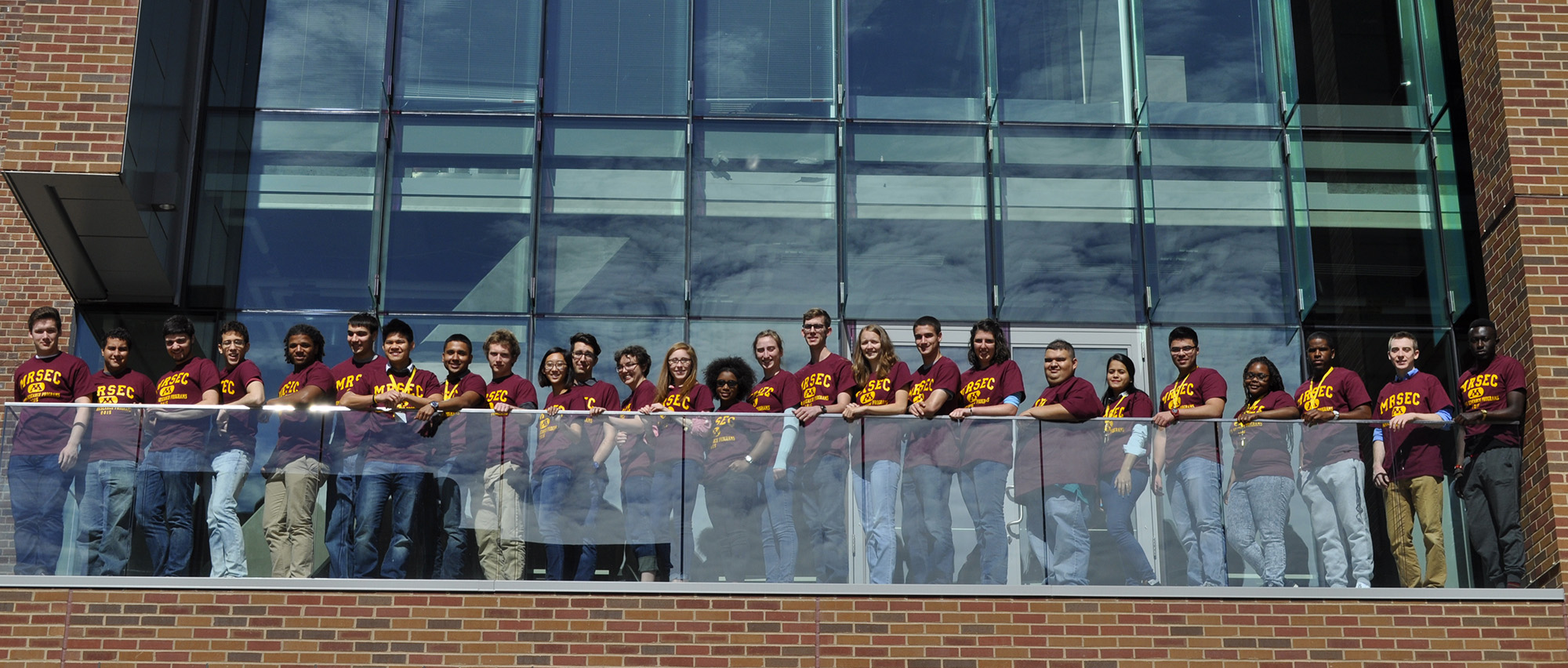

Home Institution: Penn State University
Major/Minor: Materials Science
Enhancement of High-Performance Graphene Biosensors for Cancer Detection
Once believed to be thermodynamically impossible, Graphene is currently hailed as a miracle material with amazing electrical conductivity, thermal conductivity, astounding chemical stability, and structural strength. Its unique properties make this an ideal material for biosensor applications. We use layer-by-layer self-assembly to construct few-layer-graphene (FLG) and functionalize it to detect alpha-fetoprotiens (AFP) which are key markers in patients with liver cancer. Perfecting the ability for the graphene to use AFP-antibodies to detect low amount of AFP takes precedence in this study. This is an improvement over current AFP (and similar antigen) sensing technology, such as ELISA which requires a lot of equipment, time, and technician skill, all while still being less sensitive the our graphene biosensors which in theory could detect a single AFP. Currently our ability to detect AFP, is heavily limited by the signal-noise ratio which is dominant in nano-elctronics, so we will try to overcome this by reducing contact resistance between the graphene-gold electrode interfaces.

Home Institution: University of Puerto Rico-Mayaguez
Major/Minor: Chemical Engineering
MRSEC Mentor: Bharat Jalan
Surfaces preparation of single crystalline substrates for epitaxial growth of BaSnO3
Perovskites, having a chemical formula of ABO3, exhibit a myriad of functionalities such as superconductivity, ferroelectricity, ferromagnetism and metal-insulator transitions. Interestingly, some of these properties can be observed exclusively in epitaxial thin films grown on single crystalline substrates. Advancements in deposition techniques have facilitated growth of thin films with atomic level precision, and greatly improved our understanding of these phenomena. However, in order to obtain films with smooth morphology it is essential to start with an atomically flat substrate surface. For accomplishing this task we will prepare the surfaces of SrTiO3(001), LaAlO3(001), and KTaO3(001) substrates using a combination of chemical etching and thermal annealing. Following this, growth of epitaxial BaSnO3 films will be carried out via high pressure oxygen sputtering. Substrate and film surface topologies will be studied using atomic force microscopy. Phase purity and stoichiometry of the films will be studied using wide angle X-ray diffraction (WAXRD).

Home Institution: Arizona State University
Major/Minor: Chemical Engineering
MRSEC Mentor: Paul Dauenhauer
Utilizing ZLC to Investigate Surface Barriers of Mass Transport Through Zeolites
The limiting step of catalysis in zeolites is the mass transport through the catalyst. In thin porous materials, the surface barriers become the dominant resistance to mass transfer. Hierarchal zeolites such as self-pillared pentasils are utilized for zeolite catalysis due to their low thickness, high surface area, and mesoporous framework, all of which contribute to an increase in mass transport. In order to better understand the surface barriers of mass transfer in zeolites, zero length chromatography is used. Zero length chromatography studies the adsorption and desorption in a thin porous sample over time in order to calculate the diffusivity properties. Measuring the desorption curves at different temperatures for various particle sizes will help to classify the relative surface barrier resistances in a thin, high surface area material such as the self-pillared pentasil.

Home Institution: University fo Puerto Rico at Humacao
Major/Minor: Physics Applied to Electronics
MRSEC Mentor: Chris Leighton
Growth and Characterization of Rare Earth and Transition Metal Doped BaSnO3 Thin Films via High Pressure Oxygen Sputtering
Perovskite oxides (ABO3) are a subset of complex oxides that display a staggering range of functionalities such as high Tc superconductivity, multiferroicity and colossal magnetoresistance, owing to the large choice of cations for filling up the cationic sites. Furthermore, the perovskite structure is also amenable to chemical substitutions on both A and B sites, thus providing an effective pathway for modulation of electronic properties of the host material. Recently, a very high electron mobility (~300 cm2V-1s-1) at room temperature was observed in BaSnO3. This is particularly interesting from the point of view of high mobility two-dimensional electron systems and oxide transistors. The first part of this work will consist of synthesis of BaxRE1-xSn1-yTMyO3 (RE: rare earth, TM: transition metal) sputtering targets by high temperature solid-state reaction, followed by sintering. Wide angle X-ray diffraction (WAXRD) will be used to probe phase purity and stoichiometry of the reacted product. The next step will be growth of epitaxial thin films from the synthesized targets via high pressure reactive sputtering in oxygen. High-resolution WAXRD and atomic force microscopy will be used for structural characterization in addition to electrical transport measurements for the characterization of electronic properties.

Home Institution: University of Massachusetts Amherst
Major/Minor: Chemical Engineering
MRSEC Mentor: Paul Dauenhauer
Improving Diffusion in Zeolites for an Economical Synthesis of Biofuels
It has been projected that by 2050, the United States could produce the equivalent of 8 million barrels of oil per day from lignocellulose biomass (Natural Resource Defense Council). This amount is greater than 50% of the oil used by the US transportation sector. However, the current absence of efficient and low cost conversion technologies prevents biofuels from being produced at this scale. Zeolites are microporous aluminosilicate materials that catalyze the synthesis of fuels and chemicals from crude oil, so they could be an important part of an economical biofuel synthesis. Although zeolites sufficiently increase reaction rates, the overall conversion rate is limited by diffusion through the zeolite to and from the reaction site. Therefore it is critical to develop zeolite structures with maximum diffusion rates to improve their functionality as catalysts. I will measure desorption of cyclohexane in a novel zeolite structure using a Zero Length Chromatography (ZLC) instrument. When experiments are performed at various temperatures and particle sizes, the data can be fit with the experimental model to determine values of diffusivity. I will compare the novel structure to spherical zeolites to determine if this structure can increase diffusion in zeolites and therefore drive down the cost of biofuels.

Home Institution: Gustavus Adolphus College
Major/Minor: Physics and Chemistry/ Mathematics
NNIN Mentor: Bharat Jalan
Growth Characterization of Complex Oxide Thin Films and Heterostructures via MBE
With the emergence of ionic gel gating in an electric double-layer transistor (EDLT), materials that could not be easily chemically doped, or had significant structural changes upon being doped, can now be examined. Since NdTiO3 (NTO) is a Mott-Hubbard antiferromagnetic insulator, it is a great candidate for the use of ionic gel gating in order to investigate the metal-to-insulator transition (MIT) while minimizing the changes to the lattice structure. NTO has been deposited onto a substrate using molecular beam epitaxy. The ion gel, 1-ethyl-3-methylimidazolium-bis (trifluoromethylsulfonyl) imide (EMI-TFSI), will be placed on top of the lithographically patterned NTO films and electronic measurements will be taken in a Physical Property Measurement System, which uses van der Pauw geometry. High resolution X-ray diffraction and X-ray reflectivity will be completed before and after the electronic measurements to correlate any change in electronic properties with the structure of NTO. Atomic force microscopy will be performed to measure the surface morphology.

Home Institution: The University of Texas Rio Grande Valley
Major/Minor: Chemistry/ Biology & English
MRSEC Mentor: Frank Bates
Block Copolymer Modified Thermoset Resins
Due to their remarkable chemical and thermal stability, epoxy resins have the potential to be used for a variety of industrial applications. Unfortunately, such applications are limited for the thermoset resin, which is especially brittle as a result of its highly cross-linked nature. Previous research attempts have been successful in resolving this issue by adding liquid rubber as a second phase modifier to the system; however, this method results in the forfeiture of other properties (e.g. modulus, transition glass temperature, etc.). More recent advances have demonstrated the ability of block copolymers to serve as toughening agents in epoxy resins. In fact, not only do the block copolymers increase toughness, but they are also capable of helping epoxy resins retain their key properties. Following this method, we have employed poly(ethylene-alt-propylene)-b-poly(ethylene oxide) (PEP–PEO) as our block polymer. Our study aims to determine how different parameters affect the resin’s extent of curing. The parameters to be modified include the curing procedures for the formulation of the thermosets and modifier loading in the epoxy matrix. We will measure the extent of curing using Differential Scanning Calorimetry (DSC) and Fourier Transform Infrared Spectroscopy (FTIR). Mechanical property tests will follow to evaluate the resin’s performance. These include compact tension tests for measuring fracture toughness and nanoindentation techniques for measuring modulus, hardness, and toughness.

Home Institution: Saint Augustine's University
Major/Minor: Engineering Mathematics
MRSEC Mentor: Paul Crowell
Surface States between an Electrolyte Fluid and Gallium Arsenide (GaAs)
The purpose of this project is to induce a metallic surface state in insulating n-GaAs by applying a voltage to an ionic liquid in direct contact with the GaAs. I will measure the resistivity at various temperatures from 2-300 K using the Physical Property Measurement System (PPMS) and a Van der Pauw method. Ohmic contacts to the GaAs substrate will be created by annealing Ge/Au/Ni. Then a passivation layer of SiN will be deposited, followed by epoxying a glass washer to the GaAs. We anticipate that when a sufficient voltage is applied to the ionic liquid, the temperature-dependence of the resistivity will indicate a change from insulating to metallic behavior.

Home Institution: St. Olaf College
Major/Minor: Chemistry
MRSEC Mentor: James Johns
Using Graphene Nanoribbons to Increase the Sensitivity of Fourier Transform Infrared Spectroscopy
Plasmons, collective oscillations of free electrons, have shown a potential use in increasing the sensitivity of Fourier Transform Infrared Spectroscopy (FTIR). While plasmons generally occur on metals, it has been observed that graphene nanoribbons are able to support these oscillations in the mid-IR. In order to better understand this system, the effect of the width of the nanoribbons on the plasmonic frequency (wp) and the percent transmittance will be tested. A device containing nanoribbons with widths ranging from 100 nm to 200 nm inserted between gold electrodes on a SiO2/Si substrate will be investigated using FTIR in transmission mode. Sheets of graphene on a SiO2/Si substrate will provide a control. Additionally, polarized light will be used since graphene plasmons can only form perpendicular to the nanoribbons. It is anticipated that as the width of the graphene nanoribbons increases, wp will decrease and the percent transmittance will increase.

Home Institution: University of Minnesota- Duluth
Major/Minor: Mechanical Engineering
MRSEC Mentor: Stephen Campbell
Phosphorene, an allotrope of phosphorous, has been seen to have physical properties that allow it to perform at a higher level than other 2D materials, such as grapheme, in the design of transistors. However, the problem with phosphorene lies in its fabrication. Currently, the methods used to exfoliate the surface of black phosphorous, thus producing phosphorene, results in a highly reactive 2D film of the substance when exposed to air. The aim of this research project is to expound upon current methods for exfoliating black phosphorous, and explore alternative methods for creating phosphorene. Ultimately, a method that prevents phosphorene from interacting with air will be developed, leading to ease in future fabrication of the material.

Home Institution: Ripon College
Major/Minor: Chemistry
MRSEC Mentor: Dan Frisbie
Fundamental Organic Electronics and Biosensing Applications
Organic Semiconductors have shown promise for their use in flexible and wide area electronics and biosensing devices. I will study fundamental charge transport in organic single crystals, and explore fabrication of Organic Thin Film Transistors (OTFTs) for integration with biological samples. Single crystals of rubrene, pentacene, and other organic semiconductors which transport charge through a pi-conjugated network will be grown and used to fabricate organic single crystal electrolyte gated transistors, devices useful for studying charge transport. Important parameters of semiconductors, such as carrier mobility and charge density, will be examined. The use of microfluidic capillary flow around biosensing OTFTs will allow movement of aqueous solutions through the sensor without external pumps. Advanced microfabrication techniques will be employed to determine the optimal geometry and surface chemistry of microchannels that allow capillary flow. Photolithographic techniques and SEM imaging will be employed to fabricate microchannels and characterize their geometries.

Home Institution: University of Notre Dame
Major/Minor: Chemical and Biomolecular Engineering/Catholic Social Tradition
NNIN Mentor: David Wood
Development of a Microfluidic Mimic of the Human Microvasculature
The major cause of morbidity and mortality in sickle cell disease, a genetic disorder caused by a DNA mutation, is the vaso-occlusive crisis (VOC). In a VOC, the flow of blood becomes obstructed in the microvasculature under hypoxic conditions. Clinically, the disease exhibits a wide range of phenotypic heterogeneity; however, the mechanisms determining this VOC-dependent heterogeneity remain unknown. One method to study such mechanisms is to create an in vitro disease model that accurately replicates the physiological parameters found in VOCs. To accomplish this, we will build a microfluidic device that mimics the physiological vessel architecture and oxygen concentration gradient between blood and surrounding tissue. We will use AutoCAD to design the device layers and soft photolithography to fabricate the molds. We will then cast the molds with polydimethylsiloxane (PDMS) to create a dual-layer device that diffusively couples the oxygen gradient to the microvasculature layer. Ultimately, this model will provide insight into why there exists such a broad range of phenotypic heterogeneity, allowing physicians to better diagnose disease severity. Furthermore, our model may influence the development of new treatments.

Home Institution: Bethel University
Major/Minor: Applied Physics & Computer Science
MRSEC Mentor: Sang-Hyun Oh
High-Throughput Fabrication of Nanofluidic Biosensors
Surface Plasmon Polaritons (SPP) are propagations of electromagnetic fields across a metal-dielectric interface. SPP’s are commonly created through the coupling of light to a metallic surface. A plasmonic waveguide is a metal-insulator-metal device such as a nanogap or grooves in a metal, or insulator-metal-insulator device such as a thin metallic film surrounded by dielectric material. Waveguides can be used to guide SPP’s beyond the conventional diffraction limit of light, allowing for optical measurements that would not be possible with standard techniques. We will fabricate annular nanogaps and grooves that utilize SPP’s to detect small refractive index changes of the surrounding medium and increase sensitivity by reducing critical device dimensions.

Home Institution: University of Illinois at Urbana-Champaign
Major/Minor: Materials Science and Engineering/Chemistry
MRSEC Mentor: Theresa Reineke
Synthesis and Characterization of a Diblock Copolymer Containing a Natural and Synthetic Block for Potential Gene Therapy Applications
Polymers derived from sustainable resources are of growing interest for a large variety of applications ranging from packaging, adhesives, and coatings, to water purification, personal care, and pharmaceuticals. In particular, block copolymers are an interesting class of materials that are composed of two or more monomer compositions polymerized sequentially in a blocky manner. With each block having its own distinct physical property, the block copolymers can potentially microphase separate to form interesting morphologies, such as lamellae, cylinders, and spheres, and their architectural features can be tuned. The goal of this project is to synthesize block copolymers using methylcellulose as the sustainable block and poly(2-aminoethylmethyacrylamide) as the second block to create methylcellulose-block-poly-(2-aminoethylmethacrylamide) (MC-b-PAEMAm), a diblock copolymer with potential uses for water purification, composites, and nucleic acid complexation and delivery. PAEMAm will be synthesized using a modified a chain-transfer agent (CTA) containing an alkyne by Reversible Addition-Fragmentation chain Transfer (RAFT) polymerization. The reducing end hydroxyl group of methylcellulose will be functionalized with an azide. The MC-PAEMAm will be prepared by copper-catalyzed [2+3] Huisgen cycloaddition. We are interested in using PAEMAm as the synthetic block because it can form complexes with polyanions such as DNA through electrostatic interactions. Similarly, using methylcellulose as the naturally-derived block may be a novel alternative to poly(ethylene glycol), serving as a hydrophilic polymer “coating” which enables the drug carrier to exhibit stealth behavior.

Home Institution: New Mexico State University
Major/Minor: Chemical Engineering/ Physics, Chemistry, and Materials Engineering
MRSEC Mentor: Tim Lodge
Effects of Cross-Linking on Ion Transport and Mechanical Properties in Solid Polymer Electrolytes Prepared via Polymerization-Induced Microphase Separation
Solid polymer electrolytes (SPE) have been proposed as a means of suppressing lithium dendrite formation in high energy density, rechargeable lithium metal anode batteries. Upon repeated battery cycling, dendrites grow and span the battery, resulting in premature and, often, catastrophic battery failure. Previously, our group reported on a novel polymerization induced microphase separation (PIMS) method for the production of an unprecedented high strength, high conductivity cross-linked polystyrene and poly(ethylene oxide)/ionic liquid SPE with a bicontinuous morphology and excellent temperature stability. While this method allowed for significant decoupling of mechanical and electrical properties, it was observed that, for high degrees of cross-linking, the conductivity was a factor of 10 lower than that of a SPE with a 1 to 5 divinylbenzene/styrene molar ratio. This study aims to further quantify the effects of crosslinking through electrochemical impedance spectroscopy as well as mechanical and small angle X-ray scattering measurements to elucidate the mechanism by which ion transport is hindered in highly cross-linked PIMS SPEs

Home Institution: NC State
Major/Minor: Materials Science and Engineering/Mathematics
MRSEC Mentor: Lorraine Francis
Zinc Oxide Nanocrystal Thin Films for Solar Cells
Semiconducting thin films have many applications, such as flexible electronics, transistors, and solar cells. In order to commercially produce thin films though, it is important to be able to produce at a large scale. The purpose of this research will be to use ZnO nanocrystals doped with Aluminum (Al) to make thin films using aerosol jet printing. The films will then be annealed using intense pulsed light (IPL) annealing. Aerosol jet printing and IPL annealing techniques show promise for large scale production. Aerosol jet printing uses ZnO nanocrystals suspended in ethanol. Sound waves are used to vibrate the nanocrystal solution and create an aerosol, which is then sprayed onto a substrate. In order to sinter the films, a Xenon lamp is used for IPL annealing. IPL annealing however, is intense and can cause the thin films to crack. Through modeling, it was observed that temperature peaks were much smaller when using a steal substrate. In hopes prevent cracks from occurring, three different substrates will be tested, glass, Kapton, and stainless steel. The films will then be characterized using Raman spectroscopy and x-ray diffraction.

Home Institution: University of Texas- Pan American
Major/Minor: Mechanical Engineering
MRSEC Mentor: Uwe Kortshagen
Characterization Device for Spin-coated and Spray-deposited Silicon Nanoparticles Films
Luminescent solar concentrators (LSCs) are cost-effective complements to semiconductor photovoltaics and they are able to increase the output of solar cells allowing for the integration of photovoltaic materials in large-area samples such as windows. Applications of LSCs rely on enhancing other photovoltaic materials properties, for example, extending the spectral range of absorbed solar radiation, downshifting through luminescence, collecting radiation over large area, directing generated radiation into a small output target, and improving solar cell performance. The design, construction, and testing of characterization devices was developed in order to measure quantum yield and attenuation losses of thin films embedded with silicon nano-crystals produced by non-thermal plasma deposition and hydrosilylation process. An integrating sphere was implemented to characterize spin-coated homogenous transparent films because of its ability of redistributing light due to its inner diffusive reflecting coating. Once the laser with an appropriate wavelength, power supply, design and construction of the film holders were obtained, the integrating sphere allowed the study of the oxidation, agglomeration, and ensemble quantum yield without being limited by the directionality of emission. Simultaneously, an attenuation characterization device was developed in order to study films produced via spray-deposition in order to study reabsorption, roughness losses, and reduction in the intensity of light as it propagates through the film due to absorption and scattering of light.

Home Institution: Saint Augustine's University
Major/Minor: Engineering Mathematics
MRSEC Mentor: Steven Koester
Characterization of Black Phosphorus using Raman Spectroscopy and X-Ray Diffraction
Over one hundred and one years ago the first successful synthesis of crystalline Black Phosphorus was formed. Crystalline Black Phosphorus is formed by heating white phosphorus, using a mercury catalyst and a seed crystal of black phosphorus. In 2014, black phosphorus was isolated in a two-dimensional form by exfoliation from a bulk crystal and since then there has been large research interest in the electronic and optical properties of the material. Black phosphorus has a direct band gap which is tunable with thickness and a high hole mobility making it interesting for electronic and optical applications. Recently, Professor Stephen in the electrical engineering had has successfully synthesized black phosphorus crystals and is experimenting different doping methods. I will be working on using Raman spectroscopy and X-ray diffract to characterize these black phosphorus crystals. With this being said Black Phosphorus is a fairly new material and I will use Raman Spectroscopy to characterize, measure temperature and find crystallographic orientation. I will also complete X-Ray diffraction to study the structure and atomic spacing of Black Phosphorus as well as determine the unit cell dimensions. We expect that the Black Phosphorus has a tunable band gap and high-speed capability. The thicker the layer of black phosphorus the higher band gap and the thinner the layer of Black Phosphorus the smaller the band gap. The smaller or tunable band gap should mean the on-off current ratio should became higher.

Home Institution: University of Texas-Pan American
Major/Minor: Chemistry/Biology
MRSEC Mentor: Marc Hillmyer
Synthesis of water-soluble Distyrylbenzene for application in photovoltaics
Conjugated polymers have been used in a variety of applications due to their semiconducting electronic properties.The synthesis of a conjugated polymer derivative containing the p-anisidine moiety was attempted by a modification of acyclic diene metathesis (ADMET) polymerization for application in photovoltaics. Currently, we are working in the development of a distyrylbenzene derivative containing the p-anisidine functionality. The synthesis is approached by reacting commercially available p-anisidine with trichloroacetic anhydride to produce a trichloro acetamide derivative. The presence of the trichloroacetyl group is required in order to successfully achieve bromomethylation in the subsequent step which verified with the methyl NMR peak. Following bromomethylation, the derivative is allowed to react with triethyl phosphite to produce a diethyl phosphonate derivative which was verified using phosphorus NMR. It is necessary in the next step to cleave the trichloroacetyl group and produce the primary amine derivative. The amine derivative will be reacted with sodium hydride in the presence of terephthaldehyde to produce the desired monomer structure. Proton and carbon NMR was done subsequently after the synthesis of each precursor to verify composition of the molecule.The final DSB structure will be characterized using proton, carbon, and 2D NMR along with FTIR, solution-phase UV-Vis, and fluorescence spectroscopy.

Home Institution: University of Texas-Pan American
Major/Minor: Mechanical Engineering
MRSEC Mentor: Uwe Kortshagen
Linearly- Actuated Device for Spray-Deposited Silicon Nanoparticle Films
Silicon nanocrystals (SiNCs) are to be used to make luminescent solar concentrators to complement semiconductor photovoltaics and boost the efficiency of solar cells. Nanocrystals are synthesized in a non-thermal plasma and passivated with organic ligands to allow dispersion into non-polar solvents. The resulting colloidal solutions can be spray coated to form thin, translucent films. We will embed the SiNCs with Polymethylmethacrylate (PMMA) to form a solution that will be used to spray a substrate. The solution is to be uniformly deposited onto a large substrate, embedding SiNCs in PMMA. The PMMA acts as part of the waveguide, like an optical fiber, which will also serve as a protection against oxidation. Effective luminescent solar concentrators require smooth and homogeneous silicon nanocrystal films with thicknesses on the order of a few micrometers. In order to achieve this goal, a scalable spray coating mechanism will be designed and built that will allow for the control of the solution deposition onto a linearly-actuated substrate holder. Certain parameters exist that need to be controlled with the air brush mechanism: nanoparticle solution flow rate, the distance at which the air brush is from the glass substrate, pressure differential, air flow rate, and needle size.

Home Institution: University of Wisconsin-Stout
Major/Minor: Applied Science with a concentration in Materials and Nanoscience/ Chemistry
MRSEC Mentor: Cari Dutcher
Exploring the structure effects of polymer induced flocculation of charged polystyrene microbeads
Flocculated structures are formed when negatively charged particles interact with positively charged polyelectrolytes in aqueous solutions due to charge neutralization and polymer bridging. The size, structure, and strength of the flocculated material (floc) is important in determining removal performance in water treatment. Previous work has established that the formation of optimally structured flocs depends on a variety of parameters including pH, ionic strength, polymeric dosing concentrations, and mixing conditions. In this work, we explore flocculation of micro-beads and their resultant floc structure as a function of chemical and hydrodynamic conditions. One micron fluorescently labeled polystyrene beads were flocculated using a commercially available cationic polyacrylamide. Flocs were formed by varying the concentration of polystyrene beads, the amount of charged polymer flocculent added, and mixing conditions for the solution. The structure of the resulting flocs was then analyzed using microscopy techniques in order to characterize the floc structure. The optimal polymer dosing range and mixing time for 1 µm carboxyl-modified polystyrene beads was determined to improve removal of micro-bead contaminants in water treatment applications.

Home Institution: St. Olaf College
Major/Minor: Physics and Mathematics
MRSEC Mentor: David Flannigan
Data Analysis of the Application of Ultrafast Electron Microscopy to HAMR Technology
Heat Assisted Magnetic Recording (HAMR) is a prominent emerging technique for high-density information storage. Ultrafast Electron Microscopy (UEM), by means of femtosecond temporal resolution and nanometer spatial resolution, provides unprecedented 4D imaging of HAMR dynamics. However, one of the key challenges of Ultrafast Electron Microscopy is the large amount of data that requires analysis. For my project, I will develop and apply imaging processing algorithms in MATLAB® in order to quantify dynamics present in a prototypical HAMR system consisting of a gold bead embedded in sapphire (Al2O3) that has been stroboscopically imaged via the UEM pump-probe technique. The dynamic features I am measuring include an oscillatory distortion of the Al2O3 and an instability in the diameter of the gold bead’s image. Quantifying these dynamics will hopefully provide important insights into the material properties of the system such as the Young’s modulus of the gold bead and the time required for full thermal recovery. A better understanding of the material properties and dynamic processes involved in this prototypical HAMR system will facilitate future technological innovation.

Home Institution: North Hennepin Community College
Major/Minor: Biomedical Engineering
MRSEC Mentor: Chun Wang
Biodegradable Semi-solid Polymer Composites: Improving Injectability and Drug Loading
Highly viscous, hydrophobic, and biocompatible polymers, often called semi-solid polymers (SSPs), have much potential as drug delivery systems. SSPs are readily injectable at room temperature and can be engineered to elute loaded drug molecules with zero order release profiles over extended periods of time. One such polymer, a PCL-PEG copolymer called PA11, was recently developed by Prof. Chun Wang’s group. While this polymer has several advantages, practical use of this material is hindered by issues with processing and handling (such as injectability and drug loading). We plan to manipulate the viscosity of the polymer by several methods: (1) changing the reaction time of polymerization, (2) adding Aquespheres—polysaccharide based microparticles, and (3) adding silica nanoparticles to form composites. Some guest molecules, such as model proteins and poorly water-soluble drugs, can be added to the composite. We will use tools such as rheology, differential scanning calorimetry (DSC), and dynamic light scattering (DLS) to help identify the ideal ratio of the polymer-particle mixture to sufficiently improve injectability of the material and loading of various model drugs.

Home Institution: Saint John's University
Major/Minor: Chemistry ACS with a concentration in Chemical Biology
MRSEC Mentor: Ronald Siegel
Nanocomposite Polymers with "Slimy" Renewable Surfaces
Fouling is a nonspecific adhesion of endogenous proteins and cells to the surface of materials in biological environments. Fouling can cause failure of implantable materials and devices as well as compromise their performances. A widely pursued approach is to design an antifouling surface by creating a thin hydrophilic layer for such implantable materials and devices; however, if either the coating or polymer substrate is damaged due to mechanical abrasion, the antifouling capacity can be lost. Poly-ε-caprolactone, PCL, is a well-known biodegradable and biocompatible polyester used in a wide range of medical applications while surfaces doped with hyaluronic acid have been shown to resist nonspecific protein absorption and cell adhesion. The strategy adopted in this project is to augment a bulk PCL matrix with a small volume fraction of nanoparticles consisting of an amphiphilic graft copolymer of hyaluronic acid and poly-ε-caprolactone (HA-g-PCL). Thus, as the surface of the implantable material or device goes through abrasion, the HA-g-PCL graft copolymer nanoparticles will replenish the surface with a hydrophilic slime that continues to resist protein and cell adhesion. This approach provides a means to retain the desired properties of poly-ε-caprolactone while giving it the antifouling surface features of hyaluronic acid.

Home Institution: Gonzaga University
Major/Minor: Mechanical Engineering
MRSEC Mentor: Chris Hogan
Generation and Analysis of Tungsten Oxide Nanoparticles for use in Electrochromic Applications
Tungsten oxide nanoparticles have desirable characteristics for application in thin film electrochromic devices (e.g. smart windows). Therefore, it is of importance to study how different conditions for generation of these particles affects their composition, and how that in turn affects their performance as an electrochromic material when applied as a thin film. We will be using a glowing wire generator to generate the particles. The first phase of research will focus on varying different conditions on the wire generator, and studying the effect this has on tungsten oxide particle composition. Measurements will be taken with a differential mobility analyzer (DMA) to construct a size distribution of particles, with an aerosol particle mass analyzer (APM) to construct a mass distribution of particles, and with a tandem DMA-APM setup to construct a relation between particle size and particle mass in order to determine the effective density of the generated particles. Alongside these measurements, we plan to analyze TEM images of the generated particles, likely aggregates, to construct their probable 3-dimensional structures and compare the resulting properties of these probable structures with the particle mobility measured with the DMA and APM. After analyzing particle composition, the second phase of our research will focus on examining tungsten oxide’s optical properties when deposited as a thin film, and eventually its performance as an electrochromic material

Home Institution: Tulane University
Major/Minor: Chemistry/Public Health
MRSEC Mentor: Christy Haynes
Formation of Reactive Oxygen Species by Engineered Nanomaterials
The variable size, shape, surface composition and properties of nanoparticles make them attractive for a wide range of applications. As research into the special characteristics of nanoparticles continues and their use and production in industry increases it becomes ever more important to examine the possible adverse human and ecological health effects that may result from the intentional or accidental release of nanomaterial into the environment. This project is aimed at quantifying the production of reactive oxygen species (ROS) by nanoparticles in the presence and absence of bacteria cells, in particular Shewanella oneidensis, in minimal cell media. ROS production is a major route of cytotoxicity as these compounds are capable of inducing damage to cellular membranes, disrupting membrane potential, and interfering with intercellular and intracellular signaling pathways. Preliminary growth curve experiments have shown that the material of interest is not particularly toxic to this strain of bacteria indicating the occurrence of ROS in cell cultures exposed to nanoparticles should not be significantly greater than results from control samples. Fluorescent dyes sensitive to oxidation/reduction will be employed to both characterized and quantify ROS production.
UMN MRSEC
435 Amundson Hall, 421 Washington Ave. SE, Minneapolis, MN, 55455
P: 612-626-0713 | F: 612-626-7805